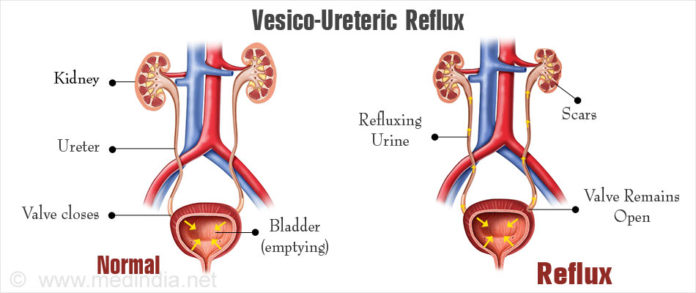Vesicoureteral reflux (VUR) is the backward flow of urine from the bladder into the kidneys. Normally, urine flows from the kidneys through the ureters to the bladder. The muscles of the bladder and ureters, along with the pressure of urine in the bladder, prevent urine from flowing backward through the ureters.
VUR allows bacteria, which may be present in the urine in the bladder, to reach the kidneys. This can lead to kidney infection, scarring, and damage.
What causes vesicoureteral reflux?
There are two types of VUR:
- Primary VUR is present at birth. It is caused by a defect in the development of the valve at the end of the tube that carries urine from the kidneys to the bladder (ureter). This is the most common type of VUR and is usually detected shortly after birth.
- Secondary VUR occurs when an obstruction in the bladder or urethra causes urine to flow backward into the kidneys. Secondary VUR can occur at any age and can be caused by surgery, injury, a pattern of emptying the bladder that’s not normal, or a past infection that puts pressure on the bladder. It is more common in children who have other birth defects, such as spina bifida.
What are the symptoms?
A urinary tract infection (UTI) can be a symptom of VUR. About one-third of children who are diagnosed with a UTI have VUR.1 Symptoms of a UTI may include fever, pain or burning with urination, frequent urination, and the feeling that the bladder does not empty completely. Fever may be the only symptom of a UTI in a small child. So a urinary tract infection should be suspected in any child who has a high fever without an obvious cause.
How is VUR diagnosed?
VUR is usually diagnosed when a urinary tract infection (UTI) is suspected. Your doctor will ask about the history of your child’s symptoms and do a physical exam.
The following tests may be recommended if UTI is suspected:
- A urine culture, to check for a UTI
- Ultrasound of the kidneys. This test uses sound waves to find out the size and shape of the kidneys. It can’t detect reflux.
- Cystourethrogram (cystogram) after the UTI has been treated. This test can detect VUR and help find out if it’s mild or severe. The voiding cystourethrogram, for example, uses an X-ray to take pictures of the urinary tract. The bladder is filled with dye, and pictures are taken of the bladder as it fills and empties.
VUR can be passed down from parent to child (inherited). If one of your children has VUR, you may want to ask your doctor to check if your other children have it too. Checking for VUR in siblings is especially helpful if your other child also has urinary tract infections. Doctors can use a cystourethrogram to see if babies who have a sibling or parent with VUR also have the condition. But experts disagree about screening for VUR, because the test involves going into the body.
How is it treated?
Many children do not need treatment for vesicoureteral reflux. The ureters grow as a child gets older. Mild cases of VUR usually go away completely by the time a child is 5 years old.
If treatment is needed, antibiotics, such as amoxicillin or trimethoprim-sulfamethoxazole (for example, Bactrim), are often prescribed. Antibiotics prevent or treat infection and help reduce the chance of scarring that can lead to kidney damage. Your child may need to take continuous antibiotic treatment. Or your doctor may give you the option of carefully watching your child for signs of another urinary tract infection and only using antibiotics when he or she gets a new infection. Frequent tests may be needed to check for bacteria in the urine.
Surgery may be needed to repair more severe cases of VUR. A surgeon may need to create new valves for the ureters to prevent the backflow of urine.
Surgery may also be needed if your child has repeated urinary tract infections while taking antibiotics or is not able to take antibiotics.



